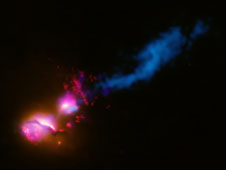Usually gas jets emitted in the process of swallowing matter by the black hole in the center of a galaxy burst into empty space, this time another galaxy stood in the way of the jet
On the same subject
Two black holes in the same galaxy
Hundreds of massive black holes have been discovered at the centers of galaxies
More on black holes

A new image taken by the Chandra X-ray Space Telescope has shown giant jets of gas erupting from one galaxy and crashing into another. When such a jet crosses the galaxy, the matter can have many implications for planet formation and can also act as a switch for a new wave of star formation.
The image includes two galaxies known by the common name 3C321 orbiting each other. X-ray images from Chandra showed that both contain supermassive black holes at their centers. The black hole at the center of the larger galaxy is in the process of massive material ingestion, meaning it is an active black hole, and a huge jet of radiation and matter is ejected from it into space. Unfortunately, the smaller galaxy was caught right in the jet's line of fire.
"We've seen many jets created by black holes, but this is the first time we've seen such a jet hit another galaxy like we see here." says Dan Evans, a Harvard-Smithsonian grant scientist for astrophysics and principal investigator on the project. "This jet can cause all kinds of problems in the small galaxy they hit."

10 תגובות
Indeed, the jets are created from gas moving at enormous speed around the black hole. Part of the gas falls into the hole and part reaches the polar region and manages to escape from the hole. There is no contradiction here since this part of the gas has not yet crossed the event horizon of the hole and can therefore escape.
By the way, there is radiation that can even come out of a black hole. This radiation is called "Hawking radiation". On the inner rim of the event horizon, pairs of a particle and an antiparticle are created from pure energy. One of the particles remains in the hole and the other is ejected from it. It is indeed a very weak radiation, but in theory, over a very long time it can "smash" the black hole.
Is it possible that black black in total transforms from matter to radiation, according to Einstein's relation e=mc**2?
And absorbs light, because light radiation also turns into another radiation?
How does a black hole emit radiation?
Only the hole is black.
A black hole swallows everything that falls into it, however, just like if you send a spaceship to a planet and it receives acceleration from its gravity and does not fall into it, so not all the material that reaches the black hole area falls into it, some is ejected out.
How does a black hole emit radiation and matter?? After all, the whole essence of a black hole is its enormous gravity that sucks all the matter, right??
In the picture we see a very interesting phenomenon
In this sense, an active black hole means a black hole that has material around it that it can suck up. Compared to an inactive black hole that has no material around it that it can pump, therefore it does not emit jets and is called "inactive".
Can someone explain what is happening in the picture?
(Enlarging it can also help...)
"The black hole at the center of the larger galaxy is in the process of massively ingesting matter, meaning it is an active black hole," does that mean there are two types of black holes? Strange because every black hole is supposed to have the same properties of swallowing matter by its very essence which is matter in close to maximum compression!
And if it is in the phase of massive ingestion, does this mean that over time it will "satiate" its hunger for matter and become an inactive black hole? Is there even such a thing as an inactive black hole?
These questions are not necessarily addressed to someone, but just pondering out loud!
Have a fruitful swallowing day for the black holes..open a big mouth!